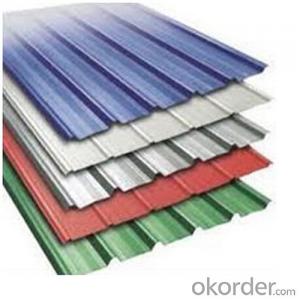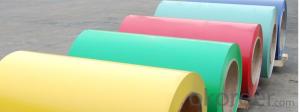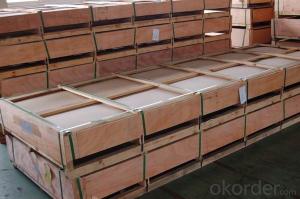3003 1060 Corrugated Aluminium Roofing Sheet
- Loading Port:
- China main port
- Payment Terms:
- TT or LC
- Min Order Qty:
- 5 m.t.
- Supply Capability:
- 5000 m.t./month
OKorder Service Pledge
OKorder Financial Service
You Might Also Like
Item specifice
1. Specifications of 3003 1060 Corrugated Aluminium Roofing Sheet
name:corrugated aluminium sheet
alloy:1000,3000
thickness:0.4mm~1.5mm
width range: 1000mm-1500mm
2. Description of 3003 1060 Corrugated Aluminium Roofing Sheet
Aluminium Corrugated sheet are rippled metal sheets, primarily used at roofing, decking, and siding. Aluminum Corrugated sheet is tough, light weight, weather resistant and practical. We can produce aluminum corrugated roofing, siding, decking, and flooring for any application.
3. Package and shipping of 3003 1060 Corrugated Aluminium Roofing Sheet
standard export package or as per customer request
4. Certificate:
SGS and ROHS(if client request, paid by client), MTC(plant provided), Certificate of Origin(FORM A, FORM E, CO), Bureau Veritas and SGS (if client request, paid by client), CIQS certificate
5. Image of 3003 1060 Corrugated Aluminium Roofing Sheet
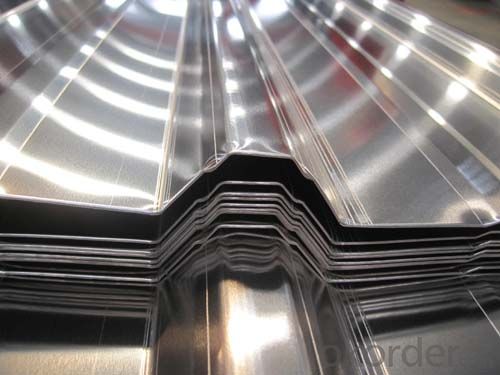
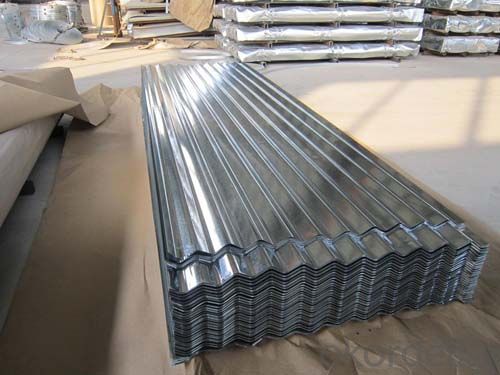
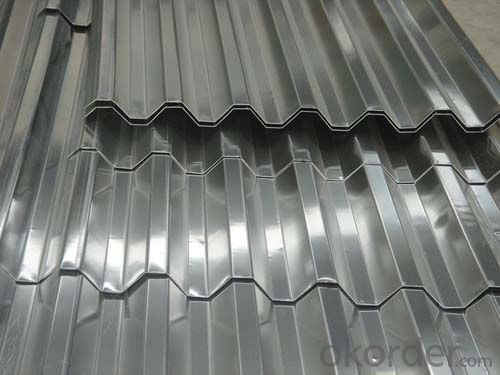
7. FAQ
1) What is the delivery time?
Dpends on actual order, around 20 to 35 days
2)What is the QC system:
We have QC staff of 20 persons and advanced equipment, each production is with MTC traced from Aluminum ingot lot.
3) What market do you mainly sell to?
8. Key Specifications/Special Features
1. Aluminum roofing sheets 2. 3003, h44. 3. Color coated as ral color chart. 4. Widely used as ware, garage roofing sheets. 3003, h44 aluminum roofing sheets can be color coated as ral color chart. It's the most widely used roofing materials in warehouse, garage for roofing sheets. We have many customers like in affrica,. During the entire production process of aluminium coating sheet from pre-treatment to finished product, we use international famous quality raw and auxiliary materials, for example aluminum sheets from the famous xinan aluminum industry and some other famous aluminum industry in china, pre-treatment made of ... With the famous germany henkel & chemtell from germany, above 70% pvdf from ppg co.,usa and the polyester coating from sweden becker industrial coating co. With the most advanced equipment and production technology, as well as top raw made of ... Brands, we produce high-quality and reliable colorful aluminium coating sheet. Theyve been widely used on the high-grade aluminum composite panel industry, now we take a lions market share and become one of the largest manufacturers in the face of the earth. Specification:. Coating type: pe (polyester resin) made of ... And pvdf (polyvinylidene fluoride) made of ... . Thickness: 0.2 ~ 1.2 mm,. Width: 800 ~ 1520 mm,. Annual production capacity: 8000 tons.
- Q:Are 101 aluminum sheets suitable for chemical processing environments?
- No, 101 aluminum sheets are not suitable for chemical processing environments as they are not corrosion-resistant and may react with certain chemicals, leading to potential damage or contamination.
- Q:What are the cost considerations when purchasing aluminum sheets?
- There are several cost considerations when purchasing aluminum sheets. Firstly, the size and thickness of the sheets will affect the price, with larger and thicker sheets generally being more expensive. Additionally, the grade and quality of the aluminum will impact the cost, as higher-grade alloys tend to be pricier. The quantity of sheets being purchased also plays a role, as bulk orders often come with discounts. Finally, transportation and delivery costs should be taken into account, especially if the supplier is located far from the buyer.
- Q:What are the standard sizes of aluminum sheets?
- The standard sizes of aluminum sheets can vary depending on the manufacturer and specific requirements. However, some commonly available standard sizes for aluminum sheets include 4 feet by 8 feet (1.2 meters by 2.4 meters), 4 feet by 10 feet (1.2 meters by 3 meters), and 5 feet by 10 feet (1.5 meters by 3 meters). These sizes are widely used in various industries and are readily available in the market. Additionally, custom sizes can also be obtained through specialized aluminum sheet suppliers to meet specific project needs.
- Q:What is the typical thickness tolerance for aluminum sheets?
- The typical thickness tolerance for aluminum sheets can vary depending on the specific application and industry standards. However, in general, the accepted thickness tolerance range for aluminum sheets is typically within ± 0.005 to ± 0.015 inches. This means that the actual thickness of the sheet may vary within this tolerance range from the specified thickness. It is important to note that different industries may have different tolerance requirements based on the intended use of the aluminum sheet, so it is always advisable to consult the relevant industry standards or specifications for specific tolerance requirements.
- Q:What are the advantages of using aluminum sheets?
- There are several advantages of using aluminum sheets in various applications. Firstly, aluminum sheets are lightweight, making them easy to transport and handle. This characteristic makes them ideal for industries where weight is a crucial factor, such as aerospace and automotive industries. Secondly, aluminum sheets have excellent corrosion resistance properties. They are naturally resistant to rust and can withstand exposure to harsh environmental conditions, including moisture, chemicals, and UV rays. This makes them highly durable and long-lasting, reducing the need for frequent maintenance and replacements. Furthermore, aluminum sheets are highly malleable and can be easily formed into different shapes and sizes. This flexibility allows for customization and versatility in design, enabling manufacturers to create complex structures and products. In addition, aluminum sheets have excellent thermal and electrical conductivity. They can efficiently dissipate heat and conduct electricity, making them suitable for applications in the electrical, heating, and cooling industries. Another advantage of using aluminum sheets is their aesthetic appeal. Aluminum has a sleek and modern appearance, making it a popular choice for architectural and interior design applications. It can be easily painted or coated to achieve different colors and finishes, further enhancing its visual appeal. Lastly, aluminum is a sustainable material. It is 100% recyclable and can be repeatedly melted and reformed without losing its properties. This makes aluminum sheets an environmentally friendly choice, contributing to the reduction of waste and carbon footprint. Overall, the advantages of using aluminum sheets include their lightweight nature, corrosion resistance, malleability, thermal and electrical conductivity, aesthetic appeal, and sustainability. These qualities make aluminum sheets a preferred material in various industries and applications.
- Q:How many molecules are in 1 square foot of aluminum foil?
- Since aluminum foil is an amalgamation of various metals you would first need to know the full chemical breakdown in order to determine how many molecules there are in a square foot of aluminum foil. That said, if your foil was 100% aluminum, you could determine the number of AL atoms by first determining the mass of the foil and dividing by the molecular weight of AL. Multiply that by 6.022 x 10^23 to determine the number of atoms.
- Q:How are aluminum sheets cleaned and maintained?
- Aluminum sheets can be effectively cleaned and maintained with a few simple steps. To begin, it is important to remove any loose dirt or debris from the surface of the sheets. This can be done by using a soft brush or cloth to gently sweep away the particles. Next, a mild detergent solution can be prepared by mixing a small amount of dish soap or a specialized aluminum cleaner with warm water. This solution should be applied to the sheets using a soft sponge or cloth. It is important to avoid using abrasive materials or cleaners that contain harsh chemicals, as these can cause damage to the aluminum surface. After applying the detergent solution, the sheets should be thoroughly rinsed with clean water to remove any residue. It is important to ensure that all soap or cleaner is completely removed, as any remaining residue can lead to staining or discoloration over time. Once the sheets are clean, they should be dried using a clean, soft cloth or towel. This will help to prevent water spots or streaks from forming on the surface. It is important to avoid using abrasive materials or rubbing too vigorously, as this can scratch the aluminum. In terms of maintenance, it is recommended to regularly inspect the aluminum sheets for any signs of damage or corrosion. If any areas are found to be damaged, they should be repaired or replaced as soon as possible to prevent further deterioration. Additionally, it is beneficial to apply a protective coating to the aluminum sheets. This can be done using a specialized aluminum sealant or a clear lacquer. This coating will help to protect the surface from environmental factors such as moisture, sunlight, and pollutants. Overall, cleaning and maintaining aluminum sheets involves regular gentle cleaning with a mild detergent solution, thorough rinsing, and drying with a soft cloth. Additionally, inspecting for damage and applying a protective coating can help to prolong the lifespan and appearance of the sheets.
- Q:Can aluminum sheet be welded?
- Yes, aluminum sheet can be welded.
- Q:What are the safety precautions when working with aluminum sheets?
- When working with aluminum sheets, some important safety precautions to consider include wearing appropriate personal protective equipment (PPE) such as gloves, safety glasses, and a dust mask to protect against cuts, eye injuries, and inhalation of aluminum dust. It is crucial to work in a well-ventilated area or use local exhaust ventilation to minimize exposure to dust and fumes. Additionally, ensuring that the work area is clean and free of clutter can help prevent slips, trips, and falls. Finally, it is essential to handle aluminum sheets with care to avoid sharp edges and to prevent heavy sheets from falling or causing injury.
- Q:What is the weight of aluminum sheets per square foot?
- The weight per square foot of aluminum sheets may differ depending on the sheet's thickness or gauge. Typically, a 1/8 inch thick aluminum sheet weighs approximately 1.9 pounds per square foot. Nevertheless, thinner sheets tend to be lighter, whereas thicker sheets can be heavier. It is crucial to take into account the precise thickness of the aluminum sheet when calculating its weight per square foot.
1. Manufacturer Overview |
|
|---|---|
| Location | |
| Year Established | |
| Annual Output Value | |
| Main Markets | |
| Company Certifications | |
2. Manufacturer Certificates |
|
|---|---|
| a) Certification Name | |
| Range | |
| Reference | |
| Validity Period | |
3. Manufacturer Capability |
|
|---|---|
| a)Trade Capacity | |
| Nearest Port | |
| Export Percentage | |
| No.of Employees in Trade Department | |
| Language Spoken: | |
| b)Factory Information | |
| Factory Size: | |
| No. of Production Lines | |
| Contract Manufacturing | |
| Product Price Range | |
Send your message to us
3003 1060 Corrugated Aluminium Roofing Sheet
- Loading Port:
- China main port
- Payment Terms:
- TT or LC
- Min Order Qty:
- 5 m.t.
- Supply Capability:
- 5000 m.t./month
OKorder Service Pledge
OKorder Financial Service
Similar products
New products
Hot products
Hot Searches
Related keywords






